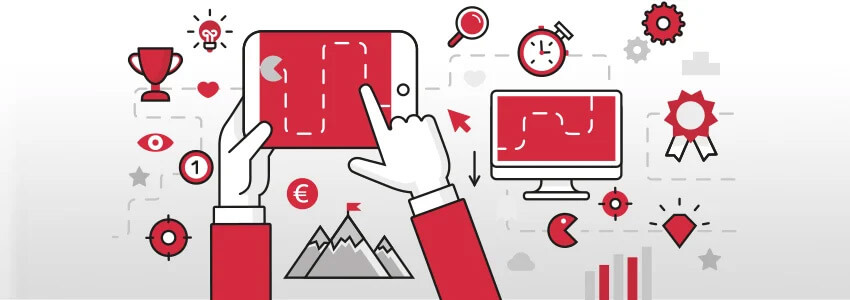People love to play and compete - it's firmly ingrained within their nature. Gamification in marketing takes advantage of these psychological characteristics. According to new studies, the gamification market is expected to grow by 30.1 per cent by 2024. This holds enormous potential for your business! That's why we have taken a closer look at the most important trends for gamification in 2022 and 2023. Let's start with...
1. Employee Onboarding
Onboarding new employees is labour-intensive and requires a lot of time. The new team members are confronted with an overwhelming amount of information as well. As a result, some companies have discovered gamification as a new method to convey knowledge in a playful way. This turns digital onboarding into a positive experience.
Large companies like Pepsi or Deloitte even invest a lot of money in these onboarding games. Deloitte, for example, has developed an educational game around the pop cultural theme zombie apocalypse: Prospective data analysts learn the basics of consulting by saving humanity in the game.
Of course, a specially developed game is not necessary, but according to a survey from 2021, the motivation and productivity of new employees may increase by up to 54 percent.
2. Digital Events
If the pandemic has shown one thing, it is the following: the potential of digital events has been underestimated for far too long! With the global necessity to engage with online events, not only technology has evolved, but also the acceptance amongst users. New formats have emerged globally and even now, when in-person meetings and events are possible again, hybrid forms are offered as second nature. In this, gamification plays an important role.
For two years, HubSpot's Inbound convention was unthinkable due to the pandemic. In 2020 and 2021, HubSpot adjusted and offered virtual workshops and lectures via streaming and community platforms. When Inbound 2022 retuned to Boston for the first time in September, HubSpot simply kept the virtual offer - giving attendees around the world the chance to participate if they couldn't make the trip.
To keep the virtual participants entertained at the digital events, the organisers like to offer surveys and small mobile games to loosen things up. This helps to reduce digital exhaustion in front of the screen and sharpens attention.
3. Mobile Apps and Social Media
According to a Gallup survey, 71 per cent of Millennials are not motivated at work. And Generation Z also seems to need special incentives to feel comfortable in midsize companies. That' s where this gamification trend comes in handy:
Companies are now incorporating gamification through mobile apps and social media. Since they often already have their own apps and social media channels, this development is not unexpected. With small games in the company app, occasional users amongst the employees become regular users.
Most people increasingly use their private smartphones at work anyway, so mobile apps are particularly well suited for customer and employee loyalty. Gamification can have a positive impact on loyalty in the workplace and gives disappointed millennials what they want: Feedback and recognition, personal growth and a purpose.
4. Virtual Reality (VR), Augmented Reality (AR) & Metaverse
Virtual worlds are already part of our reality and one of the fastest growing technologies. Not least due to the augmented reality game Pokémon, which triggered a worldwide hype in 2018. Facebook founder Mark Zuckerberg is also fully committed to Metaverse and has even rebranded his company as Meta.
The options in the Meta universe are still limited and some things are shaky, but the first companies are already investing billions, including Microsoft and Google, Walmart, Nike, Ikea or Mr Spex and Shopify. Not only are new jobs being created here, but also new marketing opportunities for companies. At Ikea you can virtually assemble Billy shelves and at Mr. Spex your avatar tries on the latest eyewear styles.
Reality and virtual worlds are playfully intermingling to create new business opportunities. Because the virtual world mainly provides access to game worlds through VR glasses such as Oculus, it is not surprising that virtual reality games are particularly well suited for marketing activities and further education.
With VR games, companies can conduct playful - and at the same time realistic - employee training, for example in risky professions or to simulate customer consultations. Augmented reality has already been utilised for product development to test design ideas in the real world.
5. Personalisation
Companies have been using personalisation in marketing for decades. So why not use it in gamification as well? Increasingly, gamification professionals are realising that the concept of one game for all is no longer enough in the highly personalised marketing world.
Potential customers want to identify with games, modify them according to their own wishes and be addressed personally. This presents great opportunities for development in game algorithms and design. Thanks to advances in artificial intelligence and machine learning, personalised elements can now be integrated into gamification much more easily.




-1.webp)



%20(1).webp)

